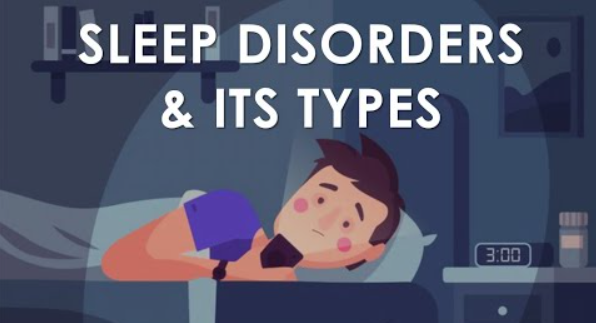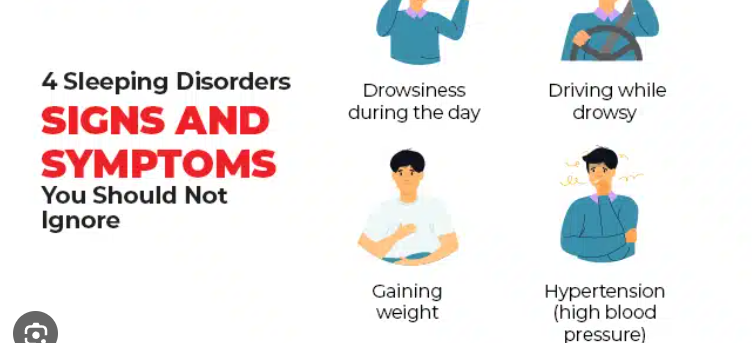Find out about the various kinds of sleep disorders, their causes, symptoms, and available treatments.
You don’t understand how fortunate you are to get a restful night’s sleep until it’s been weeks or even months. You wake up feeling exhausted rather than rejuvenated. At work, you can hardly keep your eyes open. Perhaps your snoring has caused your lover to leave your bed. You may have a sleep disorders if you are consistently getting little or no sleep.
Sleep problems are very common. According to Dr. Fariha Abbasi-Feinberg, a neurologist and the director of sleep medicine at Millennium Physician Group in Fort Myers, Florida, between 50 and 70 million Americans suffer from a sleep disturbance of some kind. Among the most prevalent are obstructive sleep apnea and insomnia. According to Abbasi, a member of the American Academy of Sleep Medicine’s board of directors, there are over 50 illnesses that fall under the category of sleep disorders.

Sleep disorders
Types of sleep disorders
Seven categories of sleep disorders are identified in the International Classification of Sleep Disorders, produced by the AASM in conjunction with several other authoritative sleep groups worldwide. Sleep disorders fall into these groups:
- Insomnia. The most common sleep disorder, insomnia, falls into two major categories: trouble falling asleep and difficulty maintaining sleep through the night.
- Respiratory issues are brought on by sleep. One such case is obstructive sleep apnea. A person experiences apnea, which is a breathing pause. The throat muscles that keep the airway open while we sleep malfunction during apnea episodes, allowing the airway to collapse. Hundreds of these incidents may happen during the course of the night.
- Central hypersomnolence diseases. The most well-known example of this category of illnesses characterized by excessive sleepiness is narcolepsy. People who suffer from narcolepsy often struggle to stay awake and focused during the day, which can make driving hazardous and interfere with their ability to perform at work or school.
- Problems related to sleep-wake cycles. Situations that momentarily or consistently deviate from the body’s natural biological clock, which is characterized by activity during the day and sleep at night accustomed sleep patterns, include jet lag and shift work sleep disorders
- Parasomnias. Unusual nighttime behavior is the hallmark of parasomnia. Sleepwalking, night terrors, sleep paralysis and REM sleep behavior disorder are common examples.
- Sleep-related movement disorders. Restless legs syndrome is among the conditions involving repetitive movements that affect sleep. “A classic example is a woman sitting on a couch watching TV with her husband,” Bhola says. “He’s sitting quietly, whereas she has to get up and walk in circles around the couch—her restless legs are bothering her so much that she has to move or stretch them.” At bedtime, a relentless need for activity and uncomfortable leg sensations can prevent you from falling asleep.
- Other sleep disorders. Some sleep-related conditions don’t fit into the categories above. One example is sundowning, when people with dementia become more confused in the evening, often leading to sleep disruption.

sleep disorders
Causes
Depending on the specific type, several factors can influence your likelihood of having a sleep disorder:
- Age.
- Other medical conditions.
- Certain medications.
- Chemical imbalances.
- Genetics.

Symptoms
Symptoms depend on the type of sleep disorder you have and how it affects your brain and body. Here’s what you may experience with certain conditions:
- Insomnia. Difficulty falling or staying asleep and early-morning awakenings are signs of insomnia. It can take patients an hour or more to fall asleep initially, Bhola says, or after waking multiple times during the night. Fatigue, moodiness, irritability and reduced concentration are common symptoms.
- Obstructive sleep apnea. “Generally, with a few exceptions, if patients don’t snore, they don’t have obstructive sleep apnea,” Aguillard says. Snoring that annoys a bed partner is often the first sign. Snoring then becomes apparent to the patients themselves. “They’ll say, ‘I’m snoring so loud that I can hear myself and wake up,'” he notes. People with severe sleep apnea can wake up short of breath. Tiredness creeps in during the day. “The proof’s in the pudding,” he says. “How well do you function during the day? If you can’t maintain your attention while driving and working, something is wrong with your sleep.”
- Narcolepsy. Extreme daytime sleepiness and feeling tired, although you had a full night’s sleep, are standard symptoms. Vivid hallucinations and a momentary feeling of paralysis can occur as you fall asleep or wake up. Some people have narcolepsy with cataplexy, or a sudden loss of muscle tone. With cataplexy, you have a brief period of partial or complete paralysis of your muscles while you’re awake, Judd explains.
- Sleepwalking. In childhood sleepwalking, “the child is in a very deep sleep and there’s something trying to wake them up,” Judd says. “They need to go to the bathroom or something like that, but they can’t fully awaken. If we’re looking at the brainwaves of somebody who is sleepwalking, they’re literally asleep. They’re walking around; they’re not aware if somebody’s talking to them.”
- Restless legs syndrome. A strong urge to move your legs after sitting or lying down for a significant period of time is a hallmark of RLS. Conversely, relief with movement such as walking, shaking your leg or stretching is also an indication. Involuntary leg twitching or kicking at night are related symptoms. People with RLS describe unpleasant crawling, throbbing, creeping, itching or electric sensations of the limbs.

Diagnosis
Your primary care physician could suggest that you get evaluated by a sleep clinic or a sleep medicine expert if you continue to have trouble sleeping. You first give a medical history and have a physical examination. You also fill out a lengthy questionnaire about sleep. “They don’t diagnose the condition, but they can point you in the direction of sleep testing,” says Bhola. Your present sleep complaint, past sleep issues, and your sleep pattern—weekday and weekend bedtimes and wake-up times, average hours spent in bed and asleep, length of time it takes you to fall asleep, and frequency of nighttime awakenings—are all included in the questionnaire.

Treatments
If you’re diagnosed with a sleep disorder, treatment may include medication alone, night-time devices, surgical procedures or lifestyle measures—known as sleep hygiene—to improve your sleep quality and quantity and reduce daytime sleepiness.

Also read-Insomnia : A Patient’s Guide To Insomnia And Its Symptoms
images source: Google
Disclaimer: The opinions and suggestions expressed in this article are solely those of the individual analysts. These are not the opinions of HNN. For more, please consult with your doctor




































